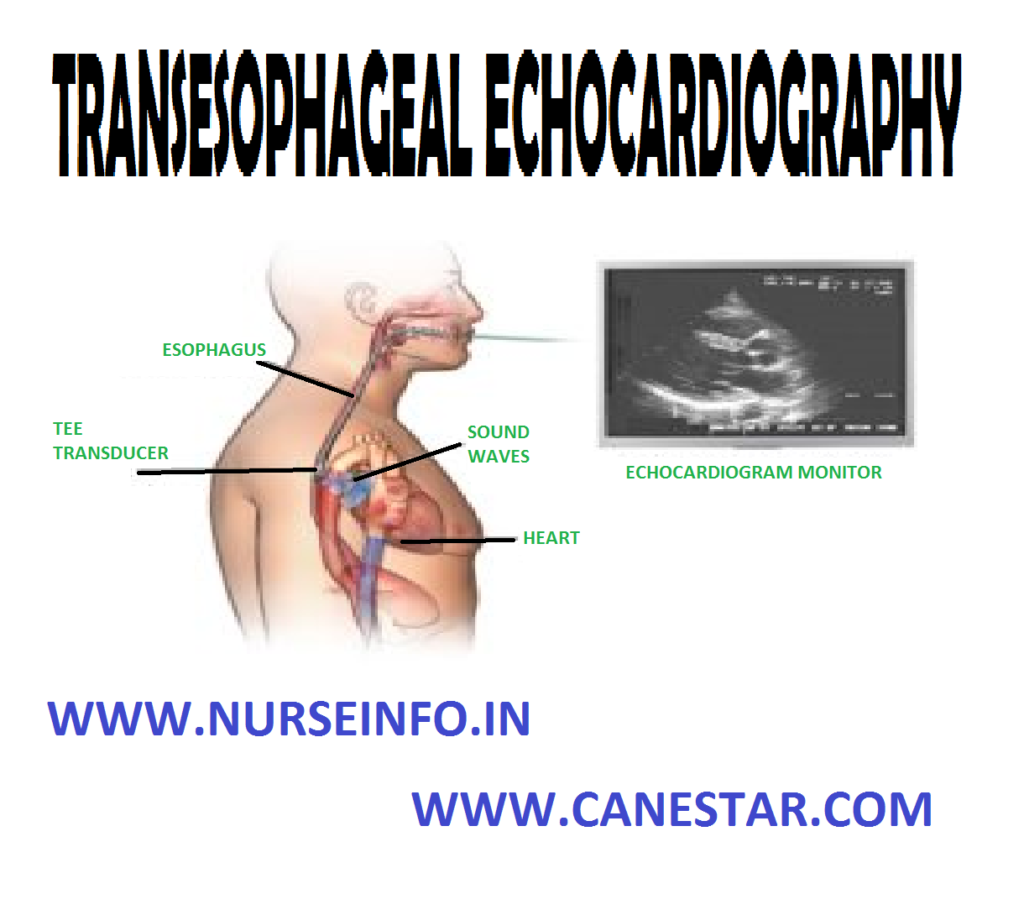TRANSESOPHAGEAL ECHOCARDIOGRAPHY – Definition, Purpose, Equipment, Pre-TTE Care, During Procedure and Post-TEE Care (NURSING PROCEDURE)
DEFINITION
It involves obtaining images of heart bypassing transesophageal echocardiography (TEE) ultrasound waves through a transducer threaded via mouth and into esophagus
PURPOSE
- To obtain precise information in guiding surgical interventions, e.g. myocardial revascularization, repair of congenital heart defects
- To provide clearer images than regular echocardiogram because ultrasound waves pass through less tissue
- To give clearer visibility of heart and it structures in patient with obesity and chronic obstructive pulmonary disease
- To aid diagnosis of cardiac mass, prosthetic valve function, aneurysm and pericardial effusions
- To assess cardiac status of patient with known cardiac disease undergoing noncardiac procedures and during cardiac surgery
EQUIPMENT
ECG machine, echo machine, skin electrodes and lead wires BP apparatus or electronic monitoring machine, oxygen prongs, endoscope and emergency equipment
Pre-TEE CARE
- Explain procedure and get the consent
- Ask patient to withhold food and fluids for 6-8 hours to procedure
- Start IV line
- Prepare skin if chest is hairy
- Explain that procedure will be done in cardiac catheterization laboratory
- Administer usual dose of morning drugs as ordered with small sips of water
- Make sure that baseline investigations are done such as blood count, electrolyte levels, ECG and regular echocardiogram
- Remove dentures/any oral prosthesis
- Administer stat dose of IV antibiotics if patient has artificial heart valve, congenital heart disease or history of infective endocarditis
- Administer sedative as prescribed
DURING PROCEDURE
- Administer sedation and topical anesthesia to back of throat as ordered
- Attach ECG electrodes to chest and to electronic monitor
- Administer oxygen if indicated through nasal prongs
- If patient has nasogastric tube in place, remove before esophageal scope is inserted
- Monitor vital signs including BP and respiratory status throughout procedure
- Transfer patient to ward when vital signs are stable
Post-TEE Care
- Monitor vital signs till stable
- Position patient in upright/side lying position to support ventilation
- Advise nil oral until gag reflex is fully restored
- Explain that mild throat discomfort will be present for a day or two
- Instruct to report to physician immediately if any significant throat discomfort, hemoptysis, dyspnoea, chest pain, etc
- Advise to take throat lozenges and saline gargles/rinses to alleviate discomfort


